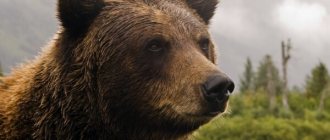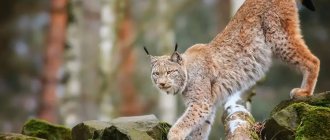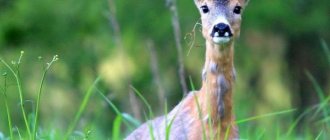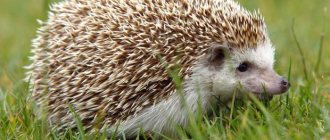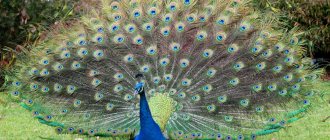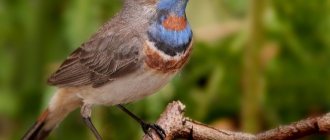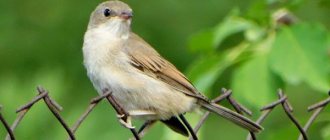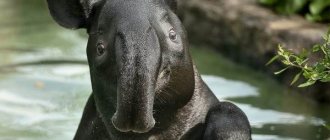The brown bear is a large predatory mammal of the genus of bears of the bear family. In modern biological taxonomy, the species includes more than 20 subspecies that differ in external characteristics. Initially, many of them were considered independent taxa, but after a detailed study of historical criteria, a decision was made to make changes to the classification of the bear genus.
Its once extensive habitat, covering Europe, much of Asia and North America, has shrunk significantly in recent centuries. The number of animals also decreased significantly, which became the reason for the inclusion of the taxon in the IUCN register. Currently, more than half of the total number of brown bears living on the planet lives in our country. To control and preserve the population, the brown bear is listed in the Red Book of Russia.
Brown bear: description
The body of a brown bear is characterized as well-developed and strong, which is typical of all representatives of this family.
Appearance
The external appearance of a brown bear is characterized by such features as high withers, a massive head, and small ears and eyes. The tail is not particularly long and ranges from 6.5 to 21 centimeters. The paws are also massive and strong, armed with powerful, non-retractable claws. The feet are five-toed and relatively wide.
Animal sizes
Brown bears living in the European part of our territory grow up to one and a half to two meters in height, with an average weight of about 200 kg. Mammals living in the middle zone are 2 times smaller in size than individuals living in the European part. Far Eastern bears, as well as grizzly bears, are among the largest representatives of this family and grow up to 3 meters in size.
Color Variations
Brown bears are characterized by a rather variable color, which depends on a number of natural factors. Although brown is considered the classic shade, fur color can range from light fawn to bluish-black.
Interesting fact! It is not difficult to distinguish a grizzly bear from its other relatives, since hairs with white ends grow on its back, which is somewhat reminiscent of gray hair. These are the representatives of the family that live in the Himalayas, but the representatives inhabiting Syria are distinguished by a reddish-brown tint.
Lifespan
In the natural environment, brown bears live no more than thirty years, although some individuals do not live up to half of this term. In artificial conditions, brown bears live much longer, living up to 50 years, or even older.
Brown bears. Documentary.
Nutrition and feeding behavior
The brown bear is a true omnivore, eating more plant food than animal food. It is most difficult for a bear to feed itself in early spring, when plant food is completely insufficient. At this time of year, he hunts large ungulates and eats carrion. Then he digs up anthills, getting larvae and the ants themselves. From the beginning of the appearance of greenery until the mass ripening of various berries, the bear spends most of its time fattening on “bear pastures” - forest clearings and meadows, eating umbelliferous plants (hogweed, angelica), sow thistle, and wild garlic. From the second half of summer, when the berries begin to ripen, throughout the forest zone bears switch to feeding on them: first blueberries, raspberries, blueberries, honeysuckle, later lingonberries, cranberries. The autumn period, the most important period for preparing for winter, is the time to eat tree fruits. In the middle zone these are acorns, hazelnuts, in the taiga - pine nuts, in the mountainous southern forests - wild apples, pears, cherries, and mulberries. The bear's favorite food in early autumn is ripening oats.
Eating grass in a meadow, the bear peacefully “grazes” for hours, like a cow or horse, or collects the stems it likes with its front paws and puts them in its mouth. Climbing fruit-bearing trees, this sweet tooth breaks off branches, eating the fruits on the spot, or throws them down, sometimes simply shaking the crown. Less agile animals graze under the trees, picking up fallen fruits.
The brown bear willingly digs into the ground, extracting succulent rhizomes and soil invertebrates, turns over stones, extracting and eating worms, beetles and other living creatures from under them.
Bears living along rivers along the Pacific coast are avid fishermen. During the course of the red fish, they gather in dozens near the rifts. While fishing, the bear goes belly-deep into the water and with a strong, quick blow of its front paw, throws a fish that has swam close to the shore.
The bear hides large ungulates - deer, elk - completely silently approaching the victim from the leeward side. Roe deer sometimes lie in wait along trails or at watering holes. His attack is swift and almost irresistible.
Types of brown bear with photos
The brown bear species consists of several subspecies, which are characterized by geographical distribution patterns, which form unique geographical races. Moreover, the subspecies differ in both color and size.
You should pay attention to the following subspecies:
- European brown bear . The following maximum indicators are considered characteristic of this subspecies: body length about 2 and a half meters, tail length about 15 cm, height at the withers about 110 cm, body weight up to 300 kg. It is considered a rather massive subspecies, with a strong body and a pronounced hump at the withers. Depending on the habitat, the coat color can range from light grayish-yellow to dark blackish-brown. The body is covered with fairly long and thick fur.
- The Caucasian brown bear is slightly smaller in size, since the maximum body length is slightly more than 2 meters, with a weight of no more than 240 kg. It differs from the European subspecies in having a less bright coat color, while its coat is short and coarse. The coat color varies from pale straw to a uniform gray-brown. A characteristic large dark spot can be seen in the withers area.
- East Siberian brown bear . It is distinguished by a large skull and weighs almost 350 kilograms. The body is covered with soft long fur, which has a characteristic shine. The coat can be colored in tones from light brown to dark brown. At the same time, there are individuals whose color includes clearly visible inclusions of yellowish or black tones.
- Ussuri or Amur brown bear. In the vastness of our country, this subspecies is also called the black grizzly. Adult males are very impressive in size, reaching a weight of almost half a ton. This subspecies is characterized by the presence of a large, physically developed skull with an elongated nasal region. The fur is almost black. The subspecies is distinguished by the presence of long hair on the ears.
One of the largest subspecies is the Far Eastern or Kamchatka brown bear, whose body weight exceeds 500 kilograms. Adult individuals are characterized by a large, massive skull, the front part of which is relatively wide and, as it were, raised upward. The body is covered with long, dense and soft fur, which is pale yellow, blackish-brown or completely black in color.
Appearance
The description of a brown bear is quite typical for a representative of the bear family. This predator is distinguished by a powerful, developed, large body. The head is massive, the ears are small, the withers are quite high. Main features of the animal:
- The tail is short, length 7-20 cm.
- The paws are muscular, developed, with non-retractable claws and wide feet with five toes.
- The average body length is 1−1.5 meters. Weight - 140−250 kg. Maximum weight - 600 kg.
- The color of the skin directly depends on the habitat and can vary from light fawn to blue-black, but the most common are brown skins of such animals.
- The coat is thick and dense.
The average life expectancy is 20−30 years in nature and up to 50 years in captivity. The largest brown bears live in the Far East and Alaska; their length and weight are 215 cm and 260 kg, respectively (males) and 195 and 170 kg (females). The most massive representative of the class known to science reached a weight of 400 kg , but scientists suggest that the animals can weigh more than 600 kg, although such animals have not yet been caught and weighed.
Molting occurs once a year and lasts from spring to autumn, which is why it is often mistakenly divided into spring and autumn.
Habitat of the brown bear
If we talk about the natural habitats of brown bears in our time, there is no clear answer to this question, since there are significant changes due to the human factor.
Until recently, the habitat of these predators extended from the borders of Great Britain to the Japanese Islands, including from Alaska to the central regions of Mexico.
Nowadays, when brown bears are actively exterminated and evicted from the regions they inhabit, the largest populations are observed in the western regions of Canada, as well as in Alaska. In our country, brown bears are found in vast forest areas that are still untouched.
Where does he live?
The natural habitat of the brown bear is vast forests with many old trees, windbreaks, and burnt areas. Animals prefer areas near swamps or rivers with moist soil and rich vegetation.
Bears avoid open spaces. The exception is mountainous areas and forest-tundra, where they choose open forests with thickets of bushes.
The animals lead a sedentary lifestyle and can leave their territory only in the event of forest fires, which devastate habitable areas for a long time.
Lifestyle of a brown bear
The predator displays its main activity in the morning and evening twilight. In this case, the animal orients itself in space due to its fine hearing and sense of smell. If we talk about the animal’s vision, it is weak. Despite their impressive size and weight, bears move easily and almost silently, thanks to fast and fairly confident movements.
Interesting to know! Bears are capable of running at speeds of up to 60 km/h. They are also excellent swimmers, but have difficulty moving in deep snow.
Brown bears lead a sedentary lifestyle, but young individuals migrate long distances in search of sexual partners. Each individual knows the boundaries of its territory, as it marks and protects it from encroachment by outsiders. When it is comfortable and warm outside, animals choose resting places for themselves, sitting on the ground among tall grass or in dense thickets of bushes. When cold weather begins to set in, adults are busy looking for places to winter.
Diet of brown bears
It is believed that brown bears, although they are predators, are omnivores. At the same time, the basis of the diet is food items of plant origin. Therefore, they feed on everything they can find on their territory: berries, nuts, acorns, roots, tubers, as well as stems of various plants. In addition, bears eat insects in the form of ants, worms, lizards, frogs, field and forest rodents.
Adults are capable of attacking juvenile artiodactyls, such as roe deer, fallow deer, deer, wild boar, moose, etc. Bears have well-developed limbs, so with one blow they can break the spine of their potential prey. After this, the predator hides the carcass in branches and leaves, after which it guards it until it is completely eaten. Bears often go to the banks of rivers, seas and oceans, where they hunt fish, seals, seals, etc.
Larger individuals are able to take prey from weaker members of their family.
It is important to know! Brown bears, regardless of age, have excellent memory, so they remember berry or mushroom areas. At the same time, they unmistakably find their way to these places.
The Far Eastern brown bear feeds on salmon going to spawn. During this period, bears actively feed, stocking up on nutrients. When the year turns out to be a lean year and a poor food supply, bears attack domestic animals or domestic animals.
Interesting facts about the brown bear:
- The skins of brown bears are used in making carpets, and the meat is eaten. The gallbladder is used in traditional Asian medicine. Healing properties are also attributed to bear fat.
- In some areas, brown bears damage crops, destroy apiaries and attack domestic animals. And although their commercial significance is small, hunting for this species in many regions is prohibited or limited. In addition, such hunting is very dangerous and requires weapons with high stopping power. Thus, hunting a brown bear with a Kalashnikov assault rifle can cause the death of the hunter, since the bear is able to kill him even after firing at point-blank range.
- Meeting brown bears in the wild can be deadly (especially with a female with cubs and cubs that have emerged from hibernation). But usually brown bears themselves avoid meeting people.
Reproduction and offspring
Somewhere in May, brown bears begin their mating season, which can last up to two months. During this period, males enter into fights for the right to fertilize a female. In this case, females can mate with several males, regardless of the outcome of the fights. Pregnancy is characterized by the fact that the development of the embryo occurs only during the period of hibernation of bears. Cubs appear after 6-8 months. They are born absolutely helpless, deaf and covered with sparse hairs. The female gives birth to 2 to 3 babies, whose length is about 25 cm and weighs about 500 grams.
Interesting fact! While in the den, the cubs feed on milk. This lasts for 3 months, after which the juveniles begin to develop milk teeth. Starting from this period, the cubs independently find food for themselves, in the form of insects, berries and vegetation. Despite this, they continue to feed on the female’s milk for another 1.5 years, or even more.
After the birth of the next offspring, which is possible once every 3 years, the babies are also cared for by the nurse daughter who appeared in the previous litter. Young bears stay near the female for 3 years until they reach puberty.
Natural habitat
Brown bears were once distributed throughout the European continent. They also lived in the northwestern countries of Africa, and also lived in most of Asia. But now the population of these animals has decreased significantly, and in some places they have completely disappeared. And the reason for this was, of course, people who not only displace bears from their natural environment, but also continue to actively hunt them.
Bears are now rare in the wild
At the moment, the habitat of brown bears is limited to the following regions:
- Russia (except for the southern regions);
- Western Europe: Pyrenees, as well as the mountain systems of the Alps and Apennines;
- Central part of Europe;
- Spruce forests of the Ukrainian and Romanian Carpathians;
- Northern European countries – Finland and Norway;
- Western Asia, Palestine, Iran and Iraq;
- Northern China and Korean Peninsula;
- Highlands of Tibet;
- Himalayas and Tien Shan Pass;
- Hokkaido Island in Japan;
- Alaska, Canada and USA.
Brown bear hibernation
Brown bears, although they hibernate during the winter, are not so active if we compare this process that occurs with other mammals. The hibernation period of a brown bear is characterized by the fact that its body temperature, breathing intensity and heart rate are almost at the same level as before hibernation. In the first days he practically does not sleep, but only dozes.
Despite this half-hibernating state, the bear listens sensitively to all sounds. In case of danger, he is ready to immediately leave the den. When the winter is warm and there is little snow, some individuals do not sleep in winter, since they can easily find food. When severe cold occurs, predators hibernate, and this period can last no more than a month. During this period, the animal feeds on subcutaneous fat, which the bear managed to accumulate before the onset of cold weather, although this is not always possible.
Preparatory period before bed
For winter sleep, bears choose deaf, dry places, within windbreaks or under the roots of fallen trees. Adults, with the help of powerful paws, dig deep and voluminous holes for themselves. In addition, they can occupy caves and crevices in rocks. Pregnant females try to dig a shelter with the future offspring in mind. After this, the den is covered from the inside with moss, spruce branches and fallen leaves.
Important point! Once born, cubs always spend the winter in a den with the female. Bear cubs that have entered their second year of life can also spend the winter in this company.
All solitary individuals spend the winter alone, although on the territory of Sakhalin and the Kuril Islands there are bears that spend the winter in the company of several of their relatives.
Duration of hibernation
Brown bears, depending on weather conditions and a number of other factors, can stay in a den for up to six months. As a rule, the bear lies down in a den after feeding on the required amount of nutrients. This process is also influenced by other factors, including the physiological state of the animals.
It is important to know! An old animal that has managed to stock up on all the necessary nutrients goes into hibernation much earlier, even before the first snow falls. Young individuals that have not had time to fatten can lie down in a den at the end of autumn or at the beginning of winter.
In this regard, the hibernation process can drag on for several weeks or months. First of all, pregnant females go to the den, and last of all, old, weakened males. A brown bear can winter in the same den for several seasons if it is not occupied by a stronger individual.
Bears-rods
Bears that for some reason were unable to stock up on fat for the winter do not hibernate and are therefore called “connecting rods.” This is due to the fact that the animal wanders around the surrounding area all winter in search of food. It is easy to distinguish him from other bears by his uncertain, shaky gait and tattered, exhausted appearance.
Interesting fact! Having met a dangerous opponent, a brown bear stands on its hind legs and lets out a loud roar. In a duel, he uses his front paws to knock down his opponent.
Often, in search of food, bears appear in places where people live. Connecting bears are quite common in northern regions where harsh winters prevail. This phenomenon can be widespread, especially in lean years, with a frequency of once every 10 years. It is often necessary to shoot such animals because they pose a certain threat to humans. Since they are hungry, they can attack humans.
Lesson on familiarization with the outside world in the middle group “A story about the life of a bear”
Irina Azarenka
Lesson on familiarization with the outside world in the middle group “A story about the life of a bear”
Goal: Expanding ideas about the life of a bear .
1. Introduce children to the bear's lifestyle.
2. Develop cognitive interest .
3. Practice your ability to answer questions about the content of the story and video .
4. Cultivate a desire to listen to a friend.
Vocabulary work: hibernation, den, connecting rod bear , apiary.
Demonstration material: bear , electronic presentation for the lesson , video “ Bear in the apiary ”
, task card.
Handouts: individual cards with a task for each child, pencils.
Preliminary work: examination of illustrations depicting a bear , conversation about the habits of a bear , a story about an apiary .
Population and species status
Brown bears are not of great commercial importance, but are the object of sport hunting and poaching. This is due to the fact that bear skins are used as floor coverings, and the meat is considered a delicacy, so it is bought by restaurants to prepare expensive dishes.
The fat of bears, as well as bile, has medicinal properties. Today, according to experts, there are no more than 200 thousand individuals on the entire earth. This fact was the reason that bears were included in the Red Book and assigned the status of “endangered”.
Popular message topics
Sports and physical education are the basis not only of the health of an individual, but also of society as a whole. There are many sports disciplines that can be classified according to the following criteria:
Chess is the favorite game of many around the globe. And not only as a game: for some, playing chess has turned into a sport, a job and a profession - there are professional chess players.
In Soviet historiography, this event was called the Great October Revolution. But in fact, what happened in October 1917 was a coup. Kerensky's power was removed without resistance. The Bolsheviks came to power.
Source

